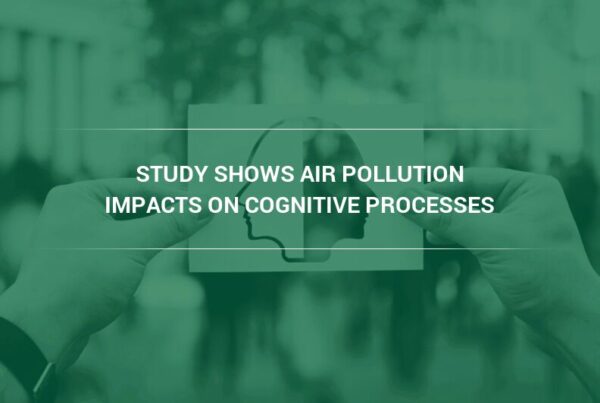Learn why exposure to poor outdoor and indoor air quality was linked to a decline in cognitive ability among the elderly, and how home air filters can help.
By now we all know that air pollution is bad for our lungs and heart. It’s why home and building owners get home air filters in the first place, the better to prevent occupants from inhaling toxic particles and chemical fumes from car exhaust, industrial facilities, and construction activities among others.
But a new study of elderly people living in China found that air pollution may also be affecting our brain function as we get older.
The study’s results, published in the Proceedings of the National Academy of Sciences, suggests that long-term exposure to air pollution may reduce cognitive performance which can range from paying attention to recalling previous knowledge and processing new information, citing a decline in verbal and math tests scores. In addition, the researchers note that as people continue to age, the connection between exposure to air pollution and mental decline becomes more apparent.
Furthermore, the researchers also found that the risk of developing cognitive problems was particularly high in men and individuals with low education attainment, adding that the loss in brain performance can be equivalent to a few years of education. Why this is happening, however, is a lot harder to explain, although the researchers hypothesize that it could be due to the different makeup of men and women’s brains.
Explaining the Links Between Air Quality and Brain Function
The research environment of the study could not have been more appropriate. Researchers Xin Zhang, Xi Chen, and Xiaobo Zhang conducted the study in China, whose cities have some of the world’s worst air pollution, causing indoor air quality in many homes and buildings to reach toxic levels.
To establish the connection between air quality and brain function, the researchers collected the language and math test scores of more than 20,000 individuals in China over a 4-year period between 2010 and 2014. They then compared this data with air pollution records during the same time period, taking a particular interest in particulate matter (PM), nitrogen dioxide (NO2), and sulfur dioxide (SO2).
The researchers found a noticeable correlation between poor air quality and lackluster test scores, confirming their hypothesis that airborne pollution may negatively affect the brain’s white matter—the brain tissue that plays an important role in a person’s language and mathematical abilities.
And because men usually have less white matter in the brain compared to women, this could explain why the researchers believe that men face a disproportionate risk of suffering a decline in their language and math abilities caused by air pollution exposure.
While these findings are far from conclusive, they aren’t exactly the first to link air pollution to a decline in brain function.
“There are many studies suggesting that air pollution, particularly fine particulate matter, can damage the brain in both humans and animals,” said Camfil USA’s Charlie Seyffer, Manager of Marketing & Technical Materials for commercial air filters and 37-year ASHRAE member and active committee participant. “Pollution from traffic is also associated with stunted brain development in children who attend schools in polluted cities and dementia in older people.”
How Home Air Filtration Systems Fight Air Pollution and Protect Brain Health
There is a substantial amount of research on air pollution and brain function, which is why experts recommend home air filtration systems not just to protect lung and heart function, but also to prevent neurodegenerative disease and brain development issues in children.
One study, for example, found that mice exposed to levels of air pollution similar to that in urban cities over a four-month period showed reduced brain function and inflammatory issues in the brain’s major regions. This meant that tissues in the brain had actually changed in structure due to the harmful effects of air pollution.
But again, more research has to be done to understand how and why this happens.
“We don’t know for sure how certain types of pollutants like particulate matter contribute to reported brain deterioration,” said Seyffer. “But what we do know is that PM2.5 is a likely culprit.”
High Efficiency Air Filtration Systems to the Rescue
PM2.5 refers to particles that are 2.5 microns or less in diameter—several times smaller than the width of a human hair. The good news is that most high-quality high-efficiency air filtration systems are perfectly capable of capturing PM down into the sub-micron size range.
The danger in PM lies in the fact that these particles have little mass, so they tend to stay airborne for hours, which only increases their likelihood of being inhaled by people. And because of their microscopic size, PM2.5 can enter the deepest recesses of the lungs and enter the bloodstream.
From here, PM2.5 can reach the body’s vital organs, including the kidneys, liver, and brain. There’s even evidence to suggest that PM2.5 can go straight to the brain through the olfactory nerves—the nerves that allow the nose to send information about smells to the brain.
In another study, postmortem brain samples of people who were exposed to severe air pollution while living in Manchester, UK and Mexico City revealed the telltale signs of Alzheimer’s disease. These included a clear buildup of plaque or protein fragments on brain cells, evidence of tissue inflammation, and an abnormally high concentration of metallic nanoparticles, include nickel, platinum, copper, and iron in the brain.
These same metals can be found in urban air pollution, mostly generated by the combustion of fossil fuels in cars, trucks, industrial facilities, and coal-fired power plants. Even constant friction on car tires and brakes can generate these particles.
Inhaling the particles found in air pollution can result in a host of negative effects on the brain’s structure, causing, among others, chronic inflammation in the brain’s nerve cells. In addition, the very act of inhaling air pollution can activate the microglia, the brain’s immune cells, which may generate dangerous reactive oxygen species with increasing frequency. This, in turn, can lead to cell damage and cell death.
Study Bolsters the Case for Installing High Efficiency Home Air Filtration Systems
In any case, the results of this latest study on the link between air pollution and a decline in cognitive performance only make the case for installing high efficiency home air filtration systems more compelling. If you have children at home, you definitely have a reason to install air purification at home, as young children are among the most vulnerable to dirty air due to their still-developing brains.
Air filter systems also address the fact that air pollution can also come from indoor sources, such as cooking, heating, lighting, and the use of cleaning products and disinfectants. While many people think that the best way to protect indoor spaces from air pollution is to keep all doors and windows shut at all times, this can also promote the buildup of indoor air pollution—do this long enough and inside conditions can end up becoming worse than outside.
Take Your Time to Shop for Home Air Purification Systems or Home Air Purifiers
If you’re serious about installing home air purifiers in your home or building, be sure to work with a trusted air filter manufacturer or distributor. Look for one who will take the time to understand your air filtration needs, including the size of the room requiring filtration, the type of pollutants present, and the existing ventilation system.
At Camfil USA, we know how important it is to keep the indoor air quality in your home clean and safe to breathe. Talk to our team to learn more about how you can protect your indoor spaces from air pollution. You may also explore our catalog of home air filters to learn more about our products.
Media Contact:
Lynne Laake
Camfil USA Air Filters
T: 888.599.6620
E: Lynne.Laake@camfil.com
F: Friend Camfil USA on Facebook
Y: Watch Camfil Videos on YouTube
Source:



